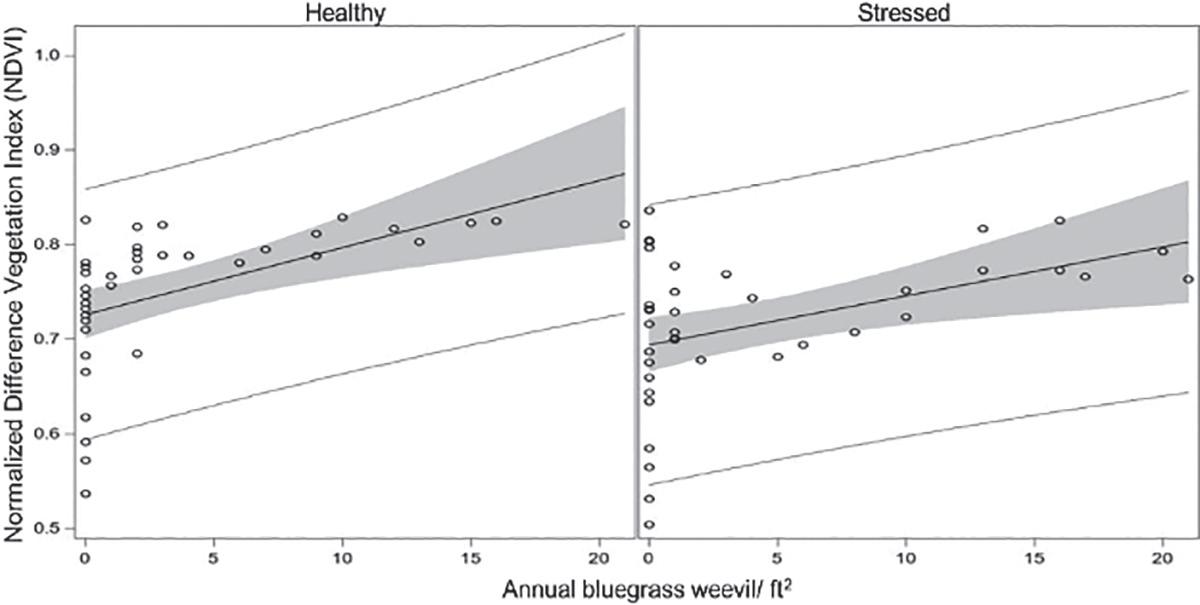
3 minute read
Research Update
Update on Annual Bluegrass Weevil Detection and Management
Authors: Alejandro Del-Pozo, Ph.D. and Tom Kuhar, Ph.D.
Advertisement
The Entomology team at Virginia Tech continued to work on providing more information for annual bluegrass weevil detection and control tactics during 2022. Consistently, this pest has had a first peak of activity from mid-March to early April during the past two years. Differences on dates for those peaks were influenced by the geographical location, where high densities have been documented earlier in eastern VA, compared to the western part of the state. Therefore, scouting remains a crucial component to improve the timing of deploying a control tactic for this devastating pest.
Light reflectance can be utilized to detect and document turfgrass areas infested by this weevil. The expectation is that ABWstressed turfgrass will have lower reflectance profiles, influencing the calculation of indexes such as the Normalized Difference Vegetative Index (NDVI). Data collected from ABW-affected golf courses during 2022 showed a correlation between ABW populations and the calculated NDVI. We observed that NDVI values of ~0.75 were associated with our lowest ABW densities (Fig. 1).
Insecticides are one of the most used methods for controlling this pest. Based on laboratory bioassays documenting the susceptibility of adults to selected insecticides, pyrethroids remained the most efficacious active ingredients to control this insect in Virginia. During these assays, adults collected from VA Beach, Richmond and Blacksburg were only exposed to be in contact with the chemical by walking on a treated filter paper inside a petri dish. Both bifenthrin (100%) and lambda-cyhalothrin (~90%) provided acceptable mortality rates on these weevils. Lower adult mortality rates (~50%) were documented from adults assayed using indoxacarb. This last chemical has limited action as a contact product, since it needs to be ingested to be effective. The Entomology team will continue to run these bioassays during 2023 to document any early signs of developing insecticide resistance from this insect.
Data from insecticide efficacy trials set up at two golf courses showed most of the treatments provided a short-term reduction of ABW adults. A combo product including the active ingredients dinotefuran + alpha-cypermethrin (Alucion), a second product containing lambda-cyhalothrin (Scimitar) and a third one with tetraniliprole (Tetrino) consistently lowered adult densities in treated plots at the 5 days after treatment (DAT) mark. Adults continued to walk into these plots from outside of the experiment, influencing densities collected by 18 DAT. Additional locations and replications of these field insecticide efficacy trials will be continued during next year. If interested in learning more about all these projects, please contact authors at adelpozo@vt.edu and tkuhar@vt.edu

Fig. 1. Normalized Difference Vegetation Index (NDVI, circles) calculated from light reflectance collected from either ‘Healthy’ (left panel) or ‘ABW-stressed’ (right panel) poa turfgrass, naturally infested with ABW adults (X-axis). Black lines represent regressions, and gray lines show the 95% confidence interval for each panel.









